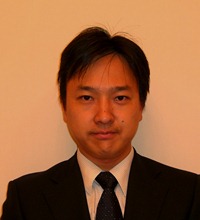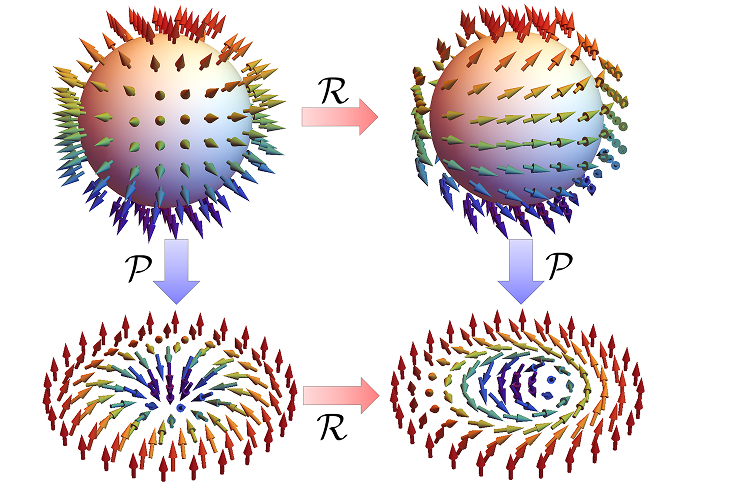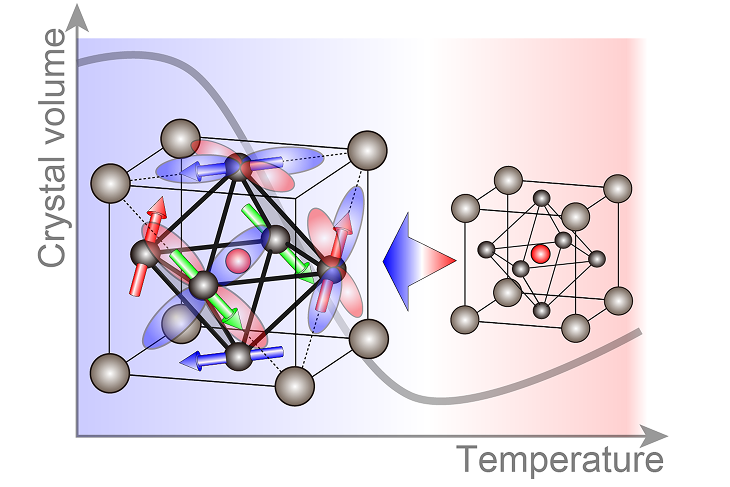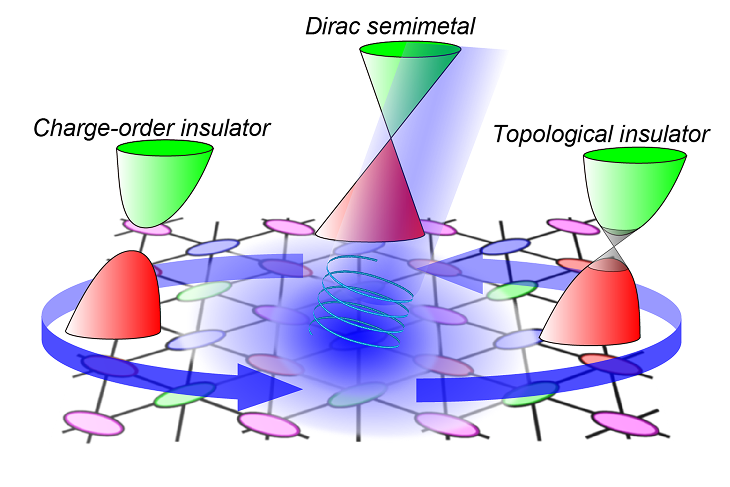
望月 維人 教授
Masahito Mochizuki
専門分野
理論物性物理学
相互作用する電子が示す創発物性現象の理論研究
研究テーマ
凝縮系物理学、強相関電子系、創発物性科学、スピントロニクス
キーワード
スピントロニクス、トポロジカル磁気構造、スキルミオン、マルチフェロイックス、光誘起相転移
LINKS
RESEARCH OVERVIEW
研究概要
望月研究室では、磁性体、強誘電体、超伝導体、金属、絶縁体と言った様々な物質が示す劇的な物性現象や豊かなデバイス機能を理論的に研究しています。出発点となるのは、物質を構成する電子の運動や相互作用を記述する、量子力学に基づいた数理モデルです。電子は、電流の担い手である「電荷」という自由度に加え、磁石としての性質を担う「スピン」自由度や、原子核の周りにどのような形状で分布するかといった「軌道」という自由度を持ちます。さらに、これらの電子の自由度は、結晶格子の構造や振動モードと結合します。このような効果を考慮して、物質の個性を反映したモデルを構築するのです。次に、構築した物理モデルを量子力学や統計力学、場の量子論、数値解析の手法などを駆使して解析し、実際の物質が示す不思議な物性現象を再現・説明したり、まったく新しい物理現象や物質機能を予言・探索したりするのです。
実は、電子1個の性質というのは、大学の学部で勉強する量子力学という学問のおかげで非常に良く分かっています。しかし、物質の性質を担う膨大な電子は、互いに強く競合・協調して絡み合うことで、1個1個の電子の単純な足し合わせとは違う、劇的で多彩な性質や現象を示します。例えば、低温で電気抵抗がゼロになる「超伝導現象」や、光や磁場をあてると絶縁体と金属の間を移り変わる「光誘起相転移」や「巨大磁気抵抗効果」、温度差を与えると発電する「熱電効果」といった現象や効果がその例です。望月研究室では、このような電子の集団が物質中で繰り広げる想像をはるかに超えたスペクタクルに、紙と鉛筆とコンピュータ、そして熱い情熱で挑みます。
ちなみに、熱い情熱の半分は、純粋な知的好奇心と真理の探究心でできていますが、もう半分は応用を視野にいれた「人類の役に立ちたい」という思いでできています。例えば、「キラル磁性体で実現するスキルミオンと呼ばれるナノ磁気渦」や「磁性と誘電性が共存するマルチフェロイックス物質」の研究は、IoT時代やビッグデータ時代に起こる情報爆発問題を解決する高性能な磁気ストレージ素子の実現につながると期待しています。また、「熱電効果」や「超伝導」の研究は、エネルギー問題解決の秘策となるかも知れません。
MESSAGE to STUDENTS
学生へのメッセージ
物理学は自然の根本原理を探究する知的冒険です。理論と数式の背後には物事の本質が潜んでいます。理論物性物理学では抽象的な思考と数学を駆使して、磁性体や超伝導体、強誘電体などの物質が示す様々な物性現象や物質機能の深層を解き明かしていきます。日々の学びの中で「なぜ?」を大切にし、既存の枠にとらわれずに思考を深めてください。物理の勉強と研究に根差した皆さんの好奇心と探究心が、未来の社会や技術、学問を切り拓いていくことを期待しています。
学歴・経歴
1998年 東京大学理学部物理学科卒業
2003年 東京大学大学院理学系研究科物理学専攻 博士課程修了 博士(理学)
2003年 日本学術振興会特別研究員(PD)
2006年 理化学研究所 基礎科学特別研究員
2007年 科学技術振興機構戦略的創造研究推進事業研究員
2009年 東京大学大学院工学系研究科・特任講師
2013年 青山学院大学理工学部物理・数理学科・准教授
2013年 科学技術振興機構さきがけ研究員(兼任)
2017年 早稲田大学先進理工学部応用物理学科・教授
所属学協会
- 日本物理学会
- 応用物理学会
- 日本磁気学会

Masahito Mochizuki
Professor
Field of study
Theoretical condensed-matter physics
Theoretical studies on emergent phenomena of materials
Research Themes
Condensed-matter physics, Strongly correlated electron systems, Emergent materials science, Spintronics
Keywords
Spintronics, Topological spin textures, Skyrmion, Multoferroics, Photoinduced phase transitions
RESEARCH OVERVIEW
We are theoretically investigating dramatic physical phenomena and rich device functions of materials such as magnets, electrics, superconductors, metals and insulators. Our starting points are microscopic models, which describe kinetics and interactions of electrons in materials based on quantum mechanics. The electrons have charge, spin, and orbital degrees of freedom, which mutually couple and correlate. Taking account of the interplays between these degrees of freedom, we first construct mathematical models for the materials. Analyzing thus constructed models using quantum mechanics, statistical mechanics, quantum field theory, and numerical techniques, we explore physics behind the amazing phenomena and predict novel physical properties and materials functions.
Properties of individual electrons are understood well, which faithfully obey quantum mechanical laws. However, once many electrons gather, the situation is no longer the same as the case of a single electron, owing to keen competition and cooperation among them. Assembly of vast amounts of electrons show drastic and rich physical phenomena, e.g., magnetism, phase transitions, superconductivities, colossal magnetoresistance. We attack these inconceivable and spectacular phenomena with pencils, papers, computers and enthusiasms as our weapons.
MESSAGE to STUDENTS
Physics is an intellectual adventure that seeks to uncover the fundamental principles of nature. Behind theories and equations lie the essence of how the world works. In theoretical condensed matter physics, we use abstract reasoning and mathematics to explore the deep mechanisms behind various physical phenomena and material functions found in magnets, superconductors, ferroelectrics, and more. As you study each day, value the question “why?” and strive to think beyond conventional frameworks. I hope that your curiosity and spirit of inquiry, grounded in the study and research of physics, will help pave the way to future advances in society, technology, and science.
Education and Career
1998: B. Sc.: Department of Physics, Faculty of Science, The University of Tokyo
2003: Ph.D. (Science): Graduate school of Science, The University of Tokyo
2003: JSPS Research Fellow (PD), Japan Society for the Promotion of Science
2006: Special Postdoctoral Researcher, RIKEN
2007: Researcher, ERATO Program, Japan Science and Technology Agency (JST)
2009: Project Lecturer, Graduate School of Engineering, The University of Tokyo
2013: Associate Professor, Department of Physics and Mathematics, Aoyama Gakuin University
2013: PRESTO Researcher, Japan Science and Technology Agency (concurrent position)
2017: Professor, Department of Applied Physics, Waseda University
Professional Memberships
- The Physical Society of Japan (JPS)
- The Japan Society of Applied Physics (JSAP)
- The Magnetics Society of Japan (MSJ)



